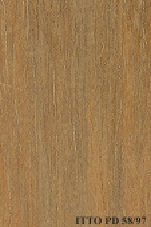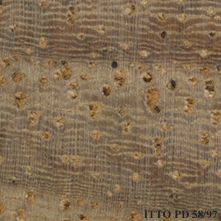
SONOKEMBANG, AMBOYNA (Pterocarpus indicus)
Trade Name
Sonokembang, Amboyna
Scientific Name
Pterocarpus indicus Willd.
Family
LEGUMINOSAE
Common Names
Amboina (Indonesia); Amboyna (United Kingdom); Amboine (France); Amboine (Germany); Andaman padauk (Andaman Islands); PNG-rosewood (Papua New Guinea); Pashu-padauk (Myanmar); Vitali (Philippines); Sena (Malaysia); Narra (Philippines); Narra (United States of America); Angsana (Indonesia); Linggua (Indonesia); Sonokembang (Indonesia); Manila-padouk (Philippines)
Scientific Name Synonyms
Pterocarpus papuana F. Muell.; Pterocarpus pallidus Blanco; Pterocarpus casteelsi var. ealaensis Hauman; Pterocarpus carolinensis Kaneh.; Pterocarpus blancoi Merr.; Lingoum wallichii (Wight & Arn.) Pierre; Lingoum indicum (Willd.) Kuntze
Description Of The Tree
Botanical Description
It is a medium-sized to fairly large tree of up to 40 m tall. The bole is often massive at mature age and up to 350 cm in diameter.
Natural Habitat
Pterocarpus indicus is a widespread tree found in lowland primary and sometimes in secondary forests, mainly along tidal creeks and rocky shores.
Natural Distribution
It is distributed in Philippines, Borneo, Myanmar, New Guinea, and the Malay Archipelago.
Plantations Available?
Cultivated populations are widely distributed throughout the tropics. It is often planted for shade along roadsides and as an ornamental. Plantations are reported in India, Sri Lanka, Taiwan, Japan, Hawaii, Central America and Africa.
Wood Identification
Anatomic Description Of Wood
Wood semi-ring porous and/or ring porous. Tangential diameter of vessel lumina 200 micras or more (large). Vestured pits. Vessels per mm2 less than 6 (rare). Simple perforation plates. Vessel-ray pits similar to intervessel pits in size and shape. Intervessel p Axial parenchyma confluent. Axial parenchyma storied. Prismatic crystals in chambered axial parenchyma cells and/or in fibers. Axial parenchyma bands more than 3 cells wide. Rays storied. Homogeneous rays and/or sub-homogeneous rays (all ray cells procumbent). Fibers with distinctly bordered pits. Fibers storied.
-
 Wood Macro Photo Tangential Plane
Wood Macro Photo Tangential Plane
-
 Wood Micro Photo Of Transversal Section
Wood Micro Photo Of Transversal Section
Availability
Cites Status
Unrestricted
General Wood Description
Odor
Its odor resembles roses.
Color
The sapwood is clearly differentiated, pale straw colored. The heartwood is deep blood-red with almost black markings, alternatively honey colored with reddish black markings, darkening to dark brown.
COLOR INDEX (1=Black, 7=Light yellow,white)
4
Grain
It is mostly interlocked or wavy.
Texture
The texture of this species is reported to vary from medium to coarse.
Luster
The wood is reported to be rather lustrous.
Natural Durability
It is reportedly resistant to termite attack.
Natural durability index (1= Very high durability, 7=Vey low durability)
2
Silica Content
Silica Content: It is reported to contain very little or no silica. Silica Value: 0.3
Resistance To Impregnation
The heartwood is resistant to preservative treatment, but the sapwood is permeable.
Wood Physical Properties
Basic Density or Specific Gravity (O.D. weight/vol. green) (g/cm³)
0.58
Air-dry Density (Weight and volume at 12%MC) (g/cm³)
0.64
Total shrinkage Tangential (Saturated to 0%MC) (%)
5.0
Total shrinkage Radial (Saturated to 0%MC) (%)
2.9
Drying Defects
Ease of Drying: Drying is very slow and difficult to perform; defects are frequent. Drying Defects: Risks of checks, distortions and collapse. Kiln Schedules: The kiln schedule has been tested.
Recommended Dry Kiln Schedule
UK-F; US-T6-D4
Dimensional stability ratio (Total Tangential Shrinkage %/Total Radial Shrinkage %)
1.7
Wood Chemical Properties
Wood Mechanical Properties
Bending Strength (MOR),12%MC (kgf/cm²)
953
Stiffness (MOE) 12%MC (kgf/cm²)
123095
Compression parallel to fiber 12%MC (kgf/cm²)
541
Compression perpendicular to fiber 12%MC (kgf/cm²)
85
Shear strength radial 12%MC (kgf/cm²)
103
Janka hardness (side) 12%MC (kgf)
453
Janka hardness (end grain) 12%MC (kgf)
497
Workability
Sawing
It is difficult because of interlocking grain.
Rotary Veneer Cutting
This species can be laminated, steaming is recommended.
Sliced Veneer
This species can be laminated, steaming is recommended.
Blunting Effect
Resin might gum up the saw teeth.
Machining
The workability of this species is reported to be fair to difficult because of interlocked grain. Special cutters required.
Planing
The presence of interlocked grain may result in picking up of grain on radial surfaces during planing.
Turning
30
Nailing
This species is reported to have a good nailing behavior.
Gluing
This species glues well.
Sanding
This species is reported to be easy to sand.
Finishing
It requires filling to achieve a good surface.
Staining
Staining of this wood is easy.
Coatings
For some material, fillers are needed.
Polishing
It polishes well if pre-filled.
Response To Hand Tools
It is easy to work with hand tools.
REFERENCED USES
End Uses Summary
HOUSING GENERAL, flooring, panelling, FURNITURE AND CABINETS, luxury furniture, PLYWOOD AND VENEER, TURNING, CONTAINERS, truck bodies, truck flooring, NAVAL CONSTRUCTION, OTHER AND MUSICAL INSTRUMENTS, handicrafts, cementboard
General Housing
- 10 - Silica in Timbers
Flooring
- 14 - Handbook of Hardwoods
Paneling
- 18 - W3TROPICOS Missouri Botanical Garden
Furniture Cabinets
- 21 - Tropical timbers of the world. Part III-Southeast Asian and Oceanian Species.
Furniture, Luxury
- 22 - Dry kiln schedules for commercial woods. Temperate and tropical. Section IV-Asian and Oceanian Woods
Panels, Veneers
- 25 - Directory of Timber Trade Malaysia
Turning
- 30 - Embassy of Honduras in Japan
Truck Body
- 53 - Timbers of the New World
Truck Flooring
- 54 - Bulletin of the Government Forest Experiment Station N.157: Identification of Tropical Woods
Shipbuilding
- 55 - Tropical Timber Atlas of Latin America
Other & Musical Instruments
- 63 - Madeiras do Brazil II
Handcraft
- 66 - Maderas latinoamericanas. VII. Caracteristicas anatomicas. propiedades fisicomecanicas, de secado, y tratabilidad de la madera juvenil de Cordia alliodora (Ruiz & Pav. Oken.)
Cementboard
- 81 - Madeiras da Amazônia: descrição do lenho de 40 espécies ocorrentes na Floresta Nacional do Tapajós
Please Provide Information To View Producer Information